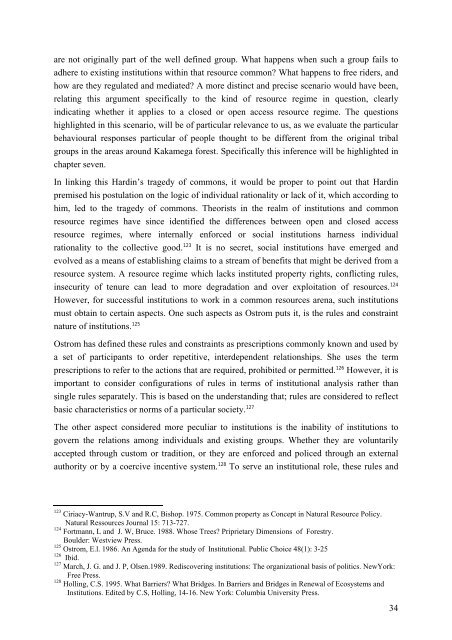THE UNIVERSITY OF LEIPZIG
THE UNIVERSITY OF LEIPZIG
THE UNIVERSITY OF LEIPZIG
Create successful ePaper yourself
Turn your PDF publications into a flip-book with our unique Google optimized e-Paper software.
are not originally part of the well defined group. What happens when such a group fails to<br />
adhere to existing institutions within that resource common? What happens to free riders, and<br />
how are they regulated and mediated? A more distinct and precise scenario would have been,<br />
relating this argument specifically to the kind of resource regime in question, clearly<br />
indicating whether it applies to a closed or open access resource regime. The questions<br />
highlighted in this scenario, will be of particular relevance to us, as we evaluate the particular<br />
behavioural responses particular of people thought to be different from the original tribal<br />
groups in the areas around Kakamega forest. Specifically this inference will be highlighted in<br />
chapter seven.<br />
In linking this Hardin’s tragedy of commons, it would be proper to point out that Hardin<br />
premised his postulation on the logic of individual rationality or lack of it, which according to<br />
him, led to the tragedy of commons. Theorists in the realm of institutions and common<br />
resource regimes have since identified the differences between open and closed access<br />
resource regimes, where internally enforced or social institutions harness individual<br />
rationality to the collective good. 123 It is no secret, social institutions have emerged and<br />
evolved as a means of establishing claims to a stream of benefits that might be derived from a<br />
resource system. A resource regime which lacks instituted property rights, conflicting rules,<br />
insecurity of tenure can lead to more degradation and over exploitation of resources. 124<br />
However, for successful institutions to work in a common resources arena, such institutions<br />
must obtain to certain aspects. One such aspects as Ostrom puts it, is the rules and constraint<br />
nature of institutions. 125<br />
Ostrom has defined these rules and constraints as prescriptions commonly known and used by<br />
a set of participants to order repetitive, interdependent relationships. She uses the term<br />
prescriptions to refer to the actions that are required, prohibited or permitted. 126 However, it is<br />
important to consider configurations of rules in terms of institutional analysis rather than<br />
single rules separately. This is based on the understanding that; rules are considered to reflect<br />
basic characteristics or norms of a particular society. 127<br />
The other aspect considered more peculiar to institutions is the inability of institutions to<br />
govern the relations among individuals and existing groups. Whether they are voluntarily<br />
accepted through custom or tradition, or they are enforced and policed through an external<br />
authority or by a coercive incentive system. 128 To serve an institutional role, these rules and<br />
123 Ciriacy-Wantrup, S.V and R.C, Bishop. 1975. Common property as Concept in Natural Resource Policy.<br />
Natural Ressources Journal 15: 713-727.<br />
124 Fortmann, L and J. W, Bruce. 1988. Whose Trees? Priprietary Dimensions of Forestry.<br />
Boulder: Westview Press.<br />
125 Ostrom, E.l. 1986. An Agenda for the study of Institutional. Public Choice 48(1): 3-25<br />
126 Ibid.<br />
127 March, J. G. and J. P, Olsen.1989. Rediscovering institutions: The organizational basis of politics. NewYork:<br />
Free Press.<br />
128 Holling, C.S. 1995. What Barriers? What Bridges. In Barriers and Bridges in Renewal of Ecosystems and<br />
Institutions. Edited by C.S, Holling, 14-16. New York: Columbia University Press.<br />
34






